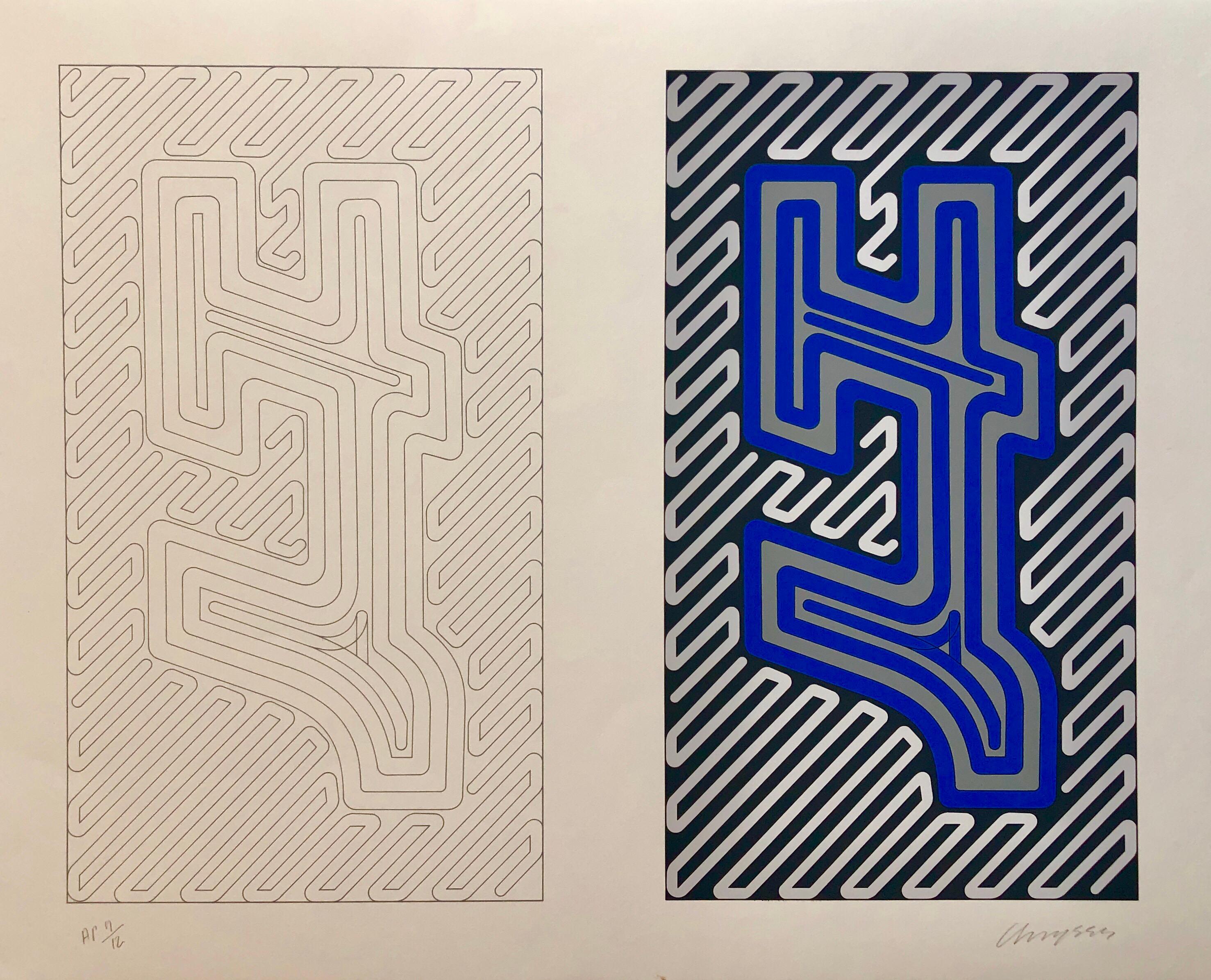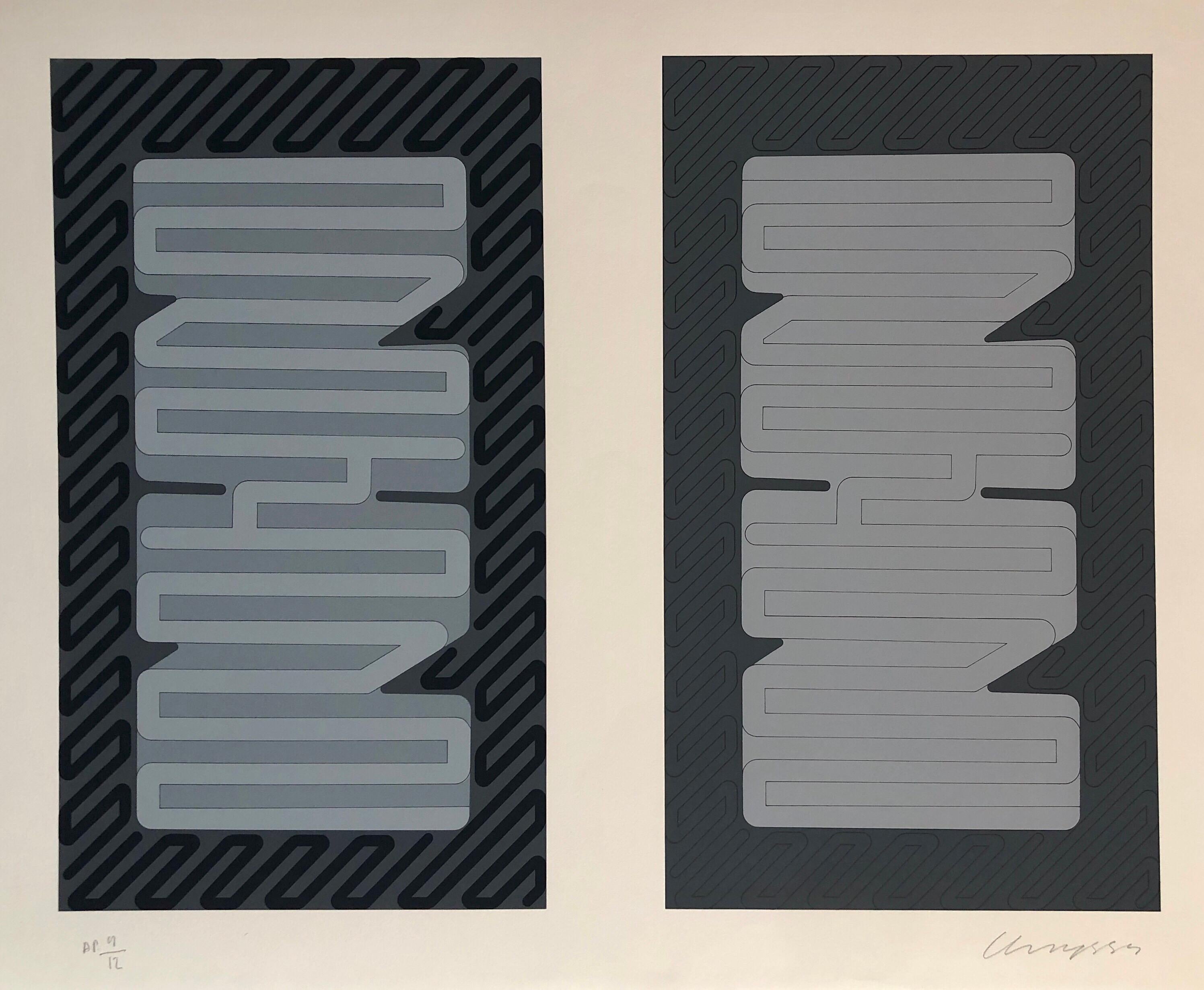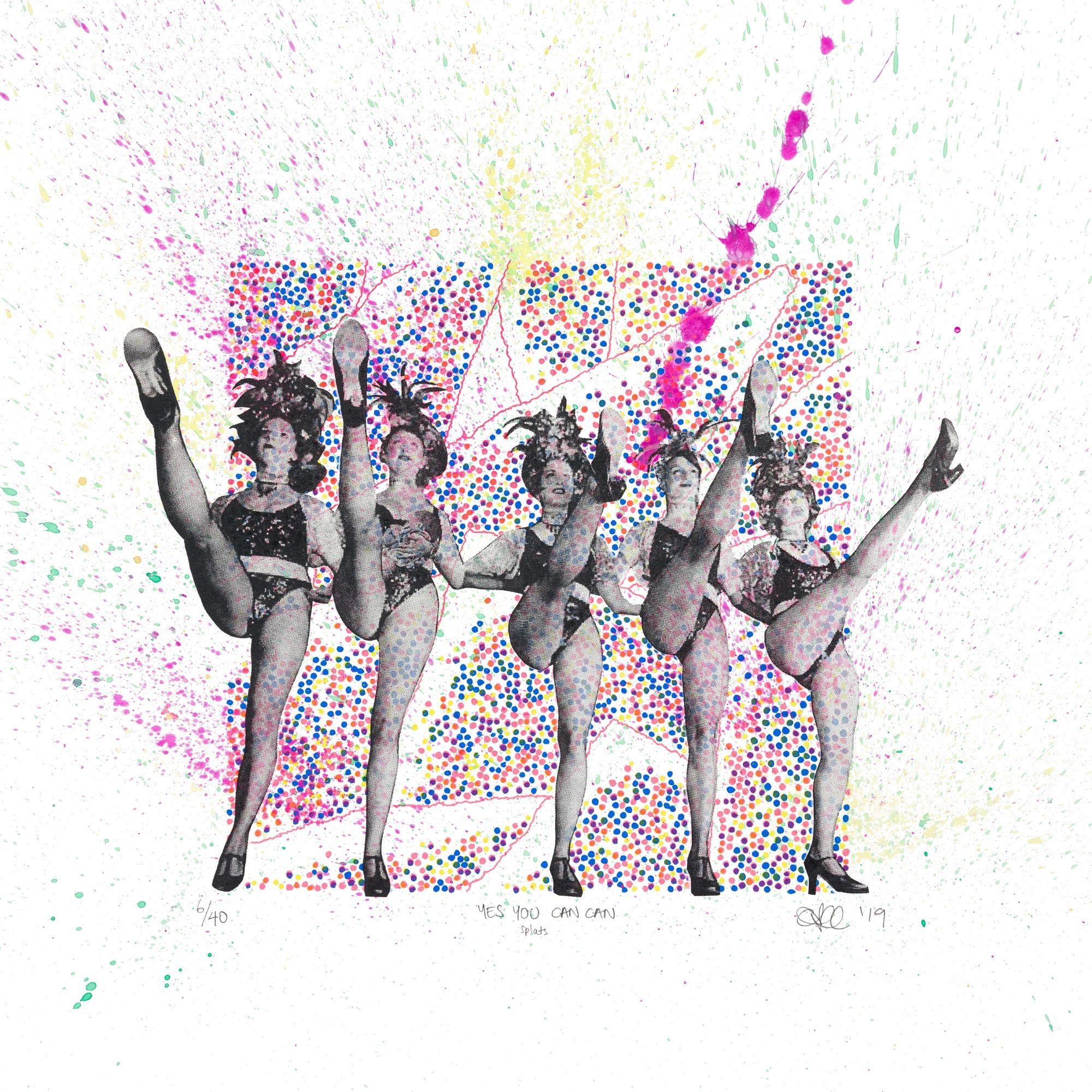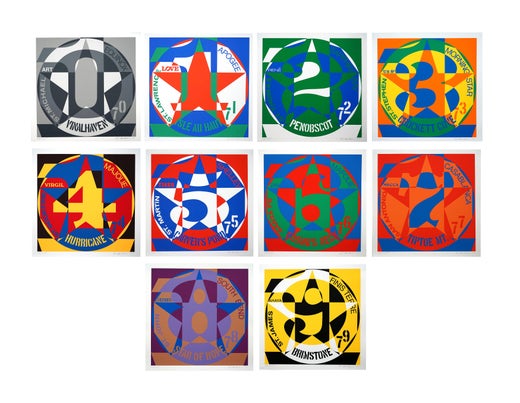Robert IndianaRobert Indiana 4 Americans in Paris MoMa Exhibition Poster1970
1970
About the Item
- Creator:Robert Indiana (1928 - 2018, American)
- Creation Year:1970
- Dimensions:Height: 46.25 in (117.48 cm)Width: 23 in (58.42 cm)Depth: 0.75 in (1.91 cm)
- Medium:
- Movement & Style:
- Period:
- Condition:Not examined outside of the frame.
- Gallery Location:Larchmont, NY
- Reference Number:
Robert Indiana
Robert Indiana's work evolved into hard-edged graphic images of words, logos and typographic forms, earning him a reputation as one of the country's leading contemporary artists.
Indiana is known for using public signs and symbols with altered lettering to make stark and challenging visual statements. In his prints, paintings and constructions, he gave new meaning to basic words like Eat, Die and Love. Using them in bold block letters in vivid colors, he enticed his viewers to look at the commonplace from a new perspective. One indication of his success was the appearance of his immensely popular multi-colored Love on a United States postage stamp in 1973.
Find a collection of original Robert Indiana art today on 1stDibs.
- ShippingRetrieving quote...Ships From: Larchmont, NY
- Return PolicyA return for this item may be initiated within 14 days of delivery.
- Sean Delonas Signed Political CartoonLocated in Larchmont, NYSean Delonas Untitled (sssuuuccckkkeeerrrsss), c. 21st century Screenprint (?) Sight: 9 1/2 x 12 3/4 in. Framed: 18 7/8 x 21 7/8 x 1 in. Signed and inscribed top Signed lower left in plate Best known as the cartoonist for the New York Post’s Page Six from 1990 to 2013. His cartoons are currently syndicated by CagleCartoons and appear worldwide. An award winning painter and illustrator, his work has appeared in the nation's largest newspapers, magazines, books, television and Broadway. Sean's work is in the permanent collections of the Smithsonian - National Museum of American History, the Library of Congress, Brooklyn Museum of Art, Newseum, the Cartoon Art Museum, New York Historical Society Museum and Library, the Billy Ireland Cartoon Library and Museum, appeared in shows at National Museum of Health and Medicine, the Norman Rockwell Museum, the Concord Museum and the Whitney Museum of American Art. Sean's cartoons were responsible for the New York Mets decision to boycott the press in 1992 (New York Daily News, 03/28/1993). In 2009, his cartoons led to worldwide media attention and the largest protest against the New York Post in it's 200+ yr history with many politicians calling for his arrest. Sean's cartoons linking Freddy Ferrer to Al Sharpton "helped decide the 2001 mayoral race" ( New York magazine, March 21-28, 2005) and were mentioned in the NYC Democrat mayoral candidate's concession speech (November 7, 2001). In 2018, New Mexico’s entire congressional delegation condemned Sean for an immigration cartoon based on Trump's State of the Union speech that appeared in the Albuquerque Journal. (New York Times, 02/08/18) A sold out one man art show at the Limner Gallery led to his largest commission -- creating the altar painting for the Church of St. Agnes in NYC. Many of his friends at the NY Post, were the models for this painting. Together with his son, is the author of Scuttle's Big Wish (ReganBooks/HarperCollins 2006 and Scholastic Books 2007) and, Sean Delonas: The Ones They Didn't Print, (Skyhorse Publishing, 2015). Pulitzer prize winner, Mike McAlary’s character, Scar [played by Glenn Fitzgerald], from CBS’s “New York News” was " drawn from that wacky talent, Sean Delonas." Mike McAlary, NEW YORK DAILY NEWS Wednesday, August 2, 1995. His work is in the private collections of celebrities, politicians, and other public figures, including George H.W. Bush, Secretary James Baker, Andrew Lloyd Weber, Rupert Murdoch, Howard Stern, George Steinbrenner, Spike Lee, Rush Limbaugh, Dan Rather, Wolf Blitzer, Steve Kroft, Mario Cuomo, John Cardinal O’Connor, Jackie Mason , Cindy Adams, Pete Hamill, David Blaine...Category
21st Century and Contemporary Contemporary More Prints
MaterialsScreen
- Adorable Tim Engelland Farmhouse Pig WoodcutLocated in Larchmont, NYTim Engelland (American, 1950-2012) Untitled, 1996 Woodcut 7 1/2 x 8 1/2 in. Signed and dated lower right: T. Engelland, 1996 Numbered lower left: 102/200 A lifelong artist, Engelland specialized in oil portraits and landscapes, and also worked extensively in woodcuts and linocuts. He was born on Jan. 5, 1950, in Ames, Iowa, the son of Charles Wilbur “Will” Engelland and Patricia Fairman Engelland.. Tim grew up in Terre Haute, IN, attending Fairbanks Elementary School and Indiana State University’s Laboratory School. He knew he wanted to be an artist from an early age, and was mentored by Lab School’s John Laska, graduating in 1968. He received a BFA from Temple University’s Tyler School of Art; was a Norfolk Fellow at Yale University; and received his MFA from Cornell University, teaching there for two years after graduation. He spent the majority of his career, from 1976-2004, at Deerfield Academy, a prestigious preparatory school in Deerfield, Mass. There he taught art and photography, coached basketball and lacrosse, and served as faculty resident. When the school began accepting female students, Tim designed The Deerfield Girl, a bronze statue to accompany The Deerfield Boy statue...Category
1990s Contemporary More Prints
MaterialsWoodcut
- Little Owl Combined Wood/Linocut by Tim EngellandLocated in Larchmont, NYTim Engelland (American, 1950-2012) Little Owl, 2006 Combined lino/woodcut 5 1/2 x 6 1/2 in. Inscribed bottom: 6/50, Little Owl - For Naomi Rosenblum, T. Engelland, 06 This "Little Owl" print was produced as a "thank you" for those who attended or purchased paintings at a show in New York. The key block originally appeared as an illustration for The O-O's Party by Paul Muldoon - published by The Gallery Press, Ireland. Redesigned to accommodate a tonal block, it is limited to an edition of fifty signed copies, printed by the artist on a 19th century proof press with archival inks and papers. A lifelong artist, Engelland specialized in oil portraits and landscapes, and also worked extensively in woodcuts and linocuts. He was born on Jan. 5, 1950, in Ames, Iowa, the son of Charles Wilbur “Will” Engelland and Patricia Fairman Engelland.. Tim grew up in Terre Haute, IN, attending Fairbanks Elementary School and Indiana State University’s Laboratory School. He knew he wanted to be an artist from an early age, and was mentored by Lab School’s John Laska, graduating in 1968. He received a BFA from Temple University’s Tyler School of Art; was a Norfolk Fellow at Yale University; and received his MFA from Cornell University, teaching there for two years after graduation. He spent the majority of his career, from 1976-2004, at Deerfield Academy, a prestigious preparatory school in Deerfield, Mass. There he taught art and photography, coached basketball and lacrosse, and served as faculty resident. When the school began accepting female students, Tim designed The Deerfield Girl, a bronze statue to accompany The Deerfield Boy statue standing in the school’s Memorial Building. Along with John O’Brien and Peter Fallon, Tim founded the Deerfield Press, publisher of limited-edition illustrated poems and stories; James Dickey, John McPhee, and Seamus Heaney are among the authors whom the Press published. For several decades, Tim served on the faculty at the Advanced Placement Summer Institute in St. Johnsbury, Vt., and as a consultant to the College Board. He spent sabbaticals in New York City and Boston, and he has exhibited in galleries in those cities and many other venues. His work can be found in the National Library of Ireland, Boston’s Museum of Fine Arts, and in private collections worldwide. In 2004, Tim returned to Indiana. He was married to Susan Karen Carpenter...Category
Early 2000s Contemporary More Prints
MaterialsWoodcut, Linocut
- Norman Rockwell-Style Woodcut by Tim EngellandLocated in Larchmont, NYTim Engelland (American, 1950-2012) Yes Sir, 1994 Woodcut 11 3/4 x 8 3/4 in. Titled, dated, and numbered bottom: Yes Sir... 60/100, 1994 Signed top: T. Engelland A lifelong artist,...Category
1990s Modern More Prints
MaterialsWoodcut
- Tim Engelland Woodcut of a RestaurantLocated in Larchmont, NYTim Engelland (American, 1950-2012) Untitled, From a Holiday Portfolio Printed for Deerfield Academy, 1992 Woodcut on Rives Lightweight Buff paper 9 1/2 x 12 1/2 in. Signed lower right and numbered 120/125 This print is from a portfolio group printed by Michael Holden at Reed Art...Category
1990s Contemporary More Prints
MaterialsWoodcut
- Quaint Snowy Cabin Woodcut by Tim EngellandLocated in Larchmont, NYTim Engelland (American, 1950-2012) Snowy Night - Hitchcock, 1993 Woodcut 8 1/2 x 9 in. Titled, numbered, signed, and dated bottom: A/Proof, "Snowy Night - Hitchcock", T. Engelland,...Category
1990s Contemporary More Prints
MaterialsWoodcut
- Marilyn Portrait (Red)By Russell YoungLocated in Washington, DCArtist: Russell Young Title: Marilyn Portrait (Red) Portfolio: Marilyn Portrait Medium: Hand-pulled acrylic and enamel silkscreen on paper Date: 2014 Edition: 25/25 Sheet Size: 27" x...Category
2010s Pop Art Portrait Prints
MaterialsEnamel
- 1970's Large Silkscreen Abstract Geometric Day Glo Serigraph Pop Art Print NeonBy Chryssa Vardea-MavromichaliLocated in Surfside, FLSilkscreen on Arches paper, Hand signed and Numbered in Pencil. Serigraph in blue gray (silver). Chryssa Vardea-Mavromichali (Greek: Χρύσα Βαρδέα-Μαυρομιχάλη; December 31, 1933 – December 23, 2013) was a Greek American artist who worked in a wide variety of media. An American art pioneer in light art and luminist sculpture widely known for her neon, steel, aluminum and acrylic glass installations, she has always used the mononym Chryssa professionally. She worked from the mid-1950s in New York City studios and worked since 1992 in the studio she established in Neos Kosmos, Athens, Greece. Chryssa was born in Athens into the famous Mavromichalis family from the Mani Peninsula. one of her sisters, who studied medicine, was a friend of the poet and novelist Nikos Kazantzakis. Chryssa began painting during her teenage years and also studied to be a social worker.In 1953, on the advice of a Greek art critic, her family sent her to Paris to study at the Académie de la Grande Chaumiere where Andre Breton, Edgard Varese, and Max Ernst were among her associates and Alberto Giacometti was a visiting professor. In 1954, at age twenty-one, Chryssa sailed for the United States, arrived in New York and went to San Francisco, California to study at the California School of Fine Arts. Returning to New York in 1955, she became a United States citizen and established a studio in the city. Chryssa's first major work was The Cycladic Books preceded American minimalism by seventeen years. 1961, Chryssa's first solo exhibition was mounted at The Guggenheim. 1963, Chryssa's work was shown at the Museum of Modern Art in curator Dorothy Canning Miller's Americans 1963 exhibition. The artists represented in the show also included Richard Anuszkiewicz, Lee Bontecou, Robert Indiana, Richard Lindner, Marisol, Claes Oldenburg, Ad Reinhardt, James Rosenquist and others. 1966, The Gates to Times Square, regarded as "one of the most important American sculptures of all time" and "a thrilling homage to the living American culture of advertising and mass communications." The work is a 10 ft cube installation of two huge letter 'A's through which visitors may walk into "a gleaming block of stainless steel and Plexiglas that seems to quiver in the play of pale blue neon light" which is controlled by programmed timers. First shown in Manhattan's Pace Gallery, it was given to the Albright-Knox Art Gallery in Buffalo, New York in 1972. 1972, The Whitney Museum of American Art mounted a solo exhibition of works by Chryssa. That's All (early 1970s), the central panel of a triptych related to The Gates of Times Square, was acquired by the Museum of Modern Art between 1975 and 1979. 1973, Chryssa's solo exhibition at the Gallerie Denise René was reviewed for TIME magazine by art critic Robert Hughes before it went on to the Galleries Denise René in Düsseldorf and Paris. Other works by Chryssa in composite honeycomb aluminum and neon in the 1980s and 1990s include Chinatown, Siren, Urban Traffic, and Flapping Birds. Chryssa 60/90 retrospective exhibition in Athens in the Mihalarias Art Center. After her long absence from Greece, a major exhibition including large aluminum sculptures - cityscapes, "neon boxes" from the Gates to the Times Square, paintings, drawings etc. was held in Athens. In 1992, after closing her SoHo studio, which art dealer Leo Castelli had described as "one of the loveliest in the world," Chryssa returned to Greece. She found a derelict cinema which had become a storeroom stacked with abandoned school desks and chairs, behind the old Fix Brewery near the city center in Neos Kosmos, Athens. Using the desks to construct enormous benches, she converted the space into a studio for working on designs and aluminum composite honeycomb sculptures...Category
1980s Pop Art Abstract Prints
MaterialsScreen
- 1970's Large Silkscreen Abstract Geometric Day Glo Serigraph Pop Art Print NeonBy Chryssa Vardea-MavromichaliLocated in Surfside, FLSilkscreen on Arches paper, Hand signed and Numbered in Pencil. Serigraph in white, back, blue gray (silver). Chryssa Vardea-Mavromichali (Greek: Χρύσα Βαρδέα-Μαυρομιχάλη; December 31, 1933 – December 23, 2013) was a Greek American artist who worked in a wide variety of media. An American art pioneer in light art and luminist sculpture widely known for her neon, steel, aluminum and acrylic glass installations, she has always used the mononym Chryssa professionally. She worked from the mid-1950s in New York City studios and worked since 1992 in the studio she established in Neos Kosmos, Athens, Greece. Chryssa was born in Athens into the famous Mavromichalis family from the Mani Peninsula. one of her sisters, who studied medicine, was a friend of the poet and novelist Nikos Kazantzakis. Chryssa began painting during her teenage years and also studied to be a social worker.In 1953, on the advice of a Greek art critic, her family sent her to Paris to study at the Académie de la Grande Chaumiere where Andre Breton, Edgard Varese, and Max Ernst were among her associates and Alberto Giacometti was a visiting professor. In 1954, at age twenty-one, Chryssa sailed for the United States, arrived in New York and went to San Francisco, California to study at the California School of Fine Arts. Returning to New York in 1955, she became a United States citizen and established a studio in the city. Chryssa's first major work was The Cycladic Books preceded American minimalism by seventeen years. 1961, Chryssa's first solo exhibition was mounted at The Guggenheim. 1963, Chryssa's work was shown at the Museum of Modern Art in curator Dorothy Canning Miller's Americans 1963 exhibition. The artists represented in the show also included Richard Anuszkiewicz, Lee Bontecou, Robert Indiana, Richard Lindner, Marisol, Claes Oldenburg, Ad Reinhardt, James Rosenquist and others. 1966, The Gates to Times Square, regarded as "one of the most important American sculptures of all time" and "a thrilling homage to the living American culture of advertising and mass communications." The work is a 10 ft cube installation of two huge letter 'A's through which visitors may walk into "a gleaming block of stainless steel and Plexiglas that seems to quiver in the play of pale blue neon light" which is controlled by programmed timers. First shown in Manhattan's Pace Gallery, it was given to the Albright-Knox Art Gallery in Buffalo, New York in 1972. 1972, The Whitney Museum of American Art mounted a solo exhibition of works by Chryssa. That's All (early 1970s), the central panel of a triptych related to The Gates of Times Square, was acquired by the Museum of Modern Art between 1975 and 1979. 1973, Chryssa's solo exhibition at the Gallerie Denise René was reviewed for TIME magazine by art critic Robert Hughes before it went on to the Galleries Denise René in Düsseldorf and Paris. Other works by Chryssa in composite honeycomb aluminum and neon in the 1980s and 1990s include Chinatown, Siren, Urban Traffic, and Flapping Birds. Chryssa 60/90 retrospective exhibition in Athens in the Mihalarias Art Center. After her long absence from Greece, a major exhibition including large aluminum sculptures - cityscapes, "neon boxes" from the Gates to the Times Square, paintings, drawings etc. was held in Athens. In 1992, after closing her SoHo studio, which art dealer Leo Castelli had described as "one of the loveliest in the world," Chryssa returned to Greece. She found a derelict cinema which had become a storeroom stacked with abandoned school desks and chairs, behind the old Fix Brewery near the city center in Neos Kosmos, Athens. Using the desks to construct enormous benches, she converted the space into a studio for working on designs and aluminum composite honeycomb sculptures...Category
1980s Pop Art Abstract Prints
MaterialsScreen
- 1970's Large Silkscreen Abstract Geometric Day Glo Serigraph Pop Art Print NeonBy Chryssa Vardea-MavromichaliLocated in Surfside, FLSilkscreen on Arches paper, Hand signed and Numbered in Pencil. Serigraph in black, gray (silver). Chryssa Vardea-Mavromichali (Greek: Χρύσα Βαρδέα-Μαυρομιχάλη; December 31, 1933 – December 23, 2013) was a Greek American artist who worked in a wide variety of media. An American art pioneer in light art and luminist sculpture widely known for her neon, steel, aluminum and acrylic glass installations, she has always used the mononym Chryssa professionally. She worked from the mid-1950s in New York City studios and worked since 1992 in the studio she established in Neos Kosmos, Athens, Greece. Chryssa was born in Athens into the famous Mavromichalis family from the Mani Peninsula. one of her sisters, who studied medicine, was a friend of the poet and novelist Nikos Kazantzakis. Chryssa began painting during her teenage years and also studied to be a social worker.In 1953, on the advice of a Greek art critic, her family sent her to Paris to study at the Académie de la Grande Chaumiere where Andre Breton, Edgard Varese, and Max Ernst were among her associates and Alberto Giacometti was a visiting professor. In 1954, at age twenty-one, Chryssa sailed for the United States, arrived in New York and went to San Francisco, California to study at the California School of Fine Arts. Returning to New York in 1955, she became a United States citizen and established a studio in the city. Chryssa's first major work was The Cycladic Books preceded American minimalism by seventeen years. 1961, Chryssa's first solo exhibition was mounted at The Guggenheim. 1963, Chryssa's work was shown at the Museum of Modern Art in curator Dorothy Canning Miller's Americans 1963 exhibition. The artists represented in the show also included Richard Anuszkiewicz, Lee Bontecou, Robert Indiana, Richard Lindner, Marisol, Claes Oldenburg, Ad Reinhardt, James Rosenquist and others. 1966, The Gates to Times Square, regarded as "one of the most important American sculptures of all time" and "a thrilling homage to the living American culture of advertising and mass communications." The work is a 10 ft cube installation of two huge letter 'A's through which visitors may walk into "a gleaming block of stainless steel and Plexiglas that seems to quiver in the play of pale blue neon light" which is controlled by programmed timers. First shown in Manhattan's Pace Gallery, it was given to the Albright-Knox Art Gallery in Buffalo, New York in 1972. 1972, The Whitney Museum of American Art mounted a solo exhibition of works by Chryssa. That's All (early 1970s), the central panel of a triptych related to The Gates of Times Square, was acquired by the Museum of Modern Art between 1975 and 1979. 1973, Chryssa's solo exhibition at the Gallerie Denise René was reviewed for TIME magazine by art critic Robert Hughes before it went on to the Galleries Denise René in Düsseldorf and Paris. Other works by Chryssa in composite honeycomb aluminum and neon in the 1980s and 1990s include Chinatown, Siren, Urban Traffic, and Flapping Birds. Chryssa 60/90 retrospective exhibition in Athens in the Mihalarias Art Center. After her long absence from Greece, a major exhibition including large aluminum sculptures - cityscapes, "neon boxes" from the Gates to the Times Square, paintings, drawings etc. was held in Athens. In 1992, after closing her SoHo studio, which art dealer Leo Castelli had described as "one of the loveliest in the world," Chryssa returned to Greece. She found a derelict cinema which had become a storeroom stacked with abandoned school desks and chairs, behind the old Fix Brewery near the city center in Neos Kosmos, Athens. Using the desks to construct enormous benches, she converted the space into a studio for working on designs and aluminum composite honeycomb sculptures...Category
1980s Pop Art Abstract Prints
MaterialsScreen
- Growing IBy Keith HaringLocated in Hollywood, FLArtist: Keith Haring Title: Growing I Size: 40 1/8 x 29 7/8 in. (101.9 x 75.9 cm) Medium: Screenprint in colors, on Lenox Museum Board, with full margins. Edition: 85 of 100 Year:...Category
1980s Pop Art More Prints
MaterialsScreen
- Yes You Can CanLocated in Deddington, GBYes You Can Can (Splats Edition) by Amy Gardner [2020] limited_edition Screen Print, Watercolour Edition number 40 Image size: H:50 cm x W:50 cm Sold Unframed Please note that insitu images are purely an indication of how a piece may look Only AP works left in this edition. This print is about women supporting women. 'YES YOU CAN CAN' splats edition limited edition of 40 Archival Bread & Butter bright white paper 270gsm 50x 50cms 5 screen...Category
21st Century and Contemporary Pop Art Figurative Prints
MaterialsPaper, Watercolor, Screen






